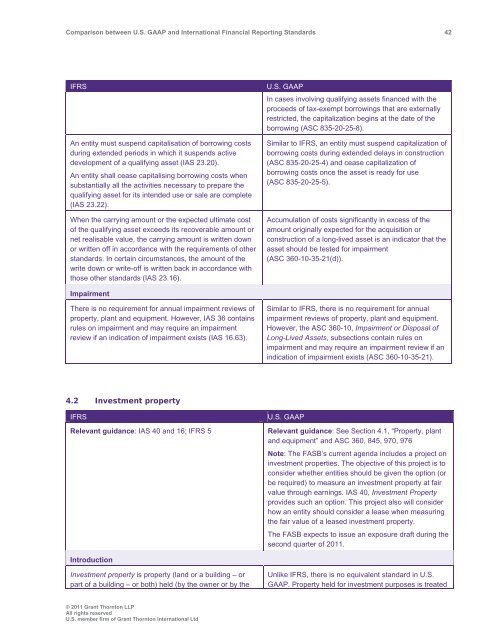Comparison between U.S. GAAP and International ... - Grant Thornton
Comparison between U.S. GAAP and International ... - Grant Thornton
Comparison between U.S. GAAP and International ... - Grant Thornton
You also want an ePaper? Increase the reach of your titles
YUMPU automatically turns print PDFs into web optimized ePapers that Google loves.
<strong>Comparison</strong> <strong>between</strong> U.S. <strong>GAAP</strong> <strong>and</strong> <strong>International</strong> Financial Reporting St<strong>and</strong>ards 42<br />
IFRS<br />
An entity must suspend capitalisation of borrowing costs<br />
during extended periods in which it suspends active<br />
development of a qualifying asset (IAS 23.20).<br />
An entity shall cease capitalising borrowing costs when<br />
substantially all the activities necessary to prepare the<br />
qualifying asset for its intended use or sale are complete<br />
(IAS 23.22).<br />
When the carrying amount or the expected ultimate cost<br />
of the qualifying asset exceeds its recoverable amount or<br />
net realisable value, the carrying amount is written down<br />
or written off in accordance with the requirements of other<br />
st<strong>and</strong>ards. In certain circumstances, the amount of the<br />
write down or write-off is written back in accordance with<br />
those other st<strong>and</strong>ards (IAS 23.16).<br />
U.S. <strong>GAAP</strong><br />
In cases involving qualifying assets financed with the<br />
proceeds of tax-exempt borrowings that are externally<br />
restricted, the capitalization begins at the date of the<br />
borrowing (ASC 835-20-25-8).<br />
Similar to IFRS, an entity must suspend capitalization of<br />
borrowing costs during extended delays in construction<br />
(ASC 835-20-25-4) <strong>and</strong> cease capitalization of<br />
borrowing costs once the asset is ready for use<br />
(ASC 835-20-25-5).<br />
Accumulation of costs significantly in excess of the<br />
amount originally expected for the acquisition or<br />
construction of a long-lived asset is an indicator that the<br />
asset should be tested for impairment<br />
(ASC 360-10-35-21(d)).<br />
Impairment<br />
There is no requirement for annual impairment reviews of<br />
property, plant <strong>and</strong> equipment. However, IAS 36 contains<br />
rules on impairment <strong>and</strong> may require an impairment<br />
review if an indication of impairment exists (IAS 16.63).<br />
Similar to IFRS, there is no requirement for annual<br />
impairment reviews of property, plant <strong>and</strong> equipment.<br />
However, the ASC 360-10, Impairment or Disposal of<br />
Long-Lived Assets, subsections contain rules on<br />
impairment <strong>and</strong> may require an impairment review if an<br />
indication of impairment exists (ASC 360-10-35-21).<br />
4.2 Investment property<br />
IFRS<br />
Relevant guidance: IAS 40 <strong>and</strong> 16; IFRS 5<br />
U.S. <strong>GAAP</strong><br />
Relevant guidance: See Section 4.1, “Property, plant<br />
<strong>and</strong> equipment” <strong>and</strong> ASC 360, 845, 970, 976<br />
Note: The FASB’s current agenda includes a project on<br />
investment properties. The objective of this project is to<br />
consider whether entities should be given the option (or<br />
be required) to measure an investment property at fair<br />
value through earnings. IAS 40, Investment Property<br />
provides such an option. This project also will consider<br />
how an entity should consider a lease when measuring<br />
the fair value of a leased investment property.<br />
The FASB expects to issue an exposure draft during the<br />
second quarter of 2011.<br />
Introduction<br />
Investment property is property (l<strong>and</strong> or a building – or<br />
part of a building – or both) held (by the owner or by the<br />
Unlike IFRS, there is no equivalent st<strong>and</strong>ard in U.S.<br />
<strong>GAAP</strong>. Property held for investment purposes is treated<br />
© 2011 <strong>Grant</strong> <strong>Thornton</strong> LLP<br />
All rights reserved<br />
U.S. member firm of <strong>Grant</strong> <strong>Thornton</strong> <strong>International</strong> Ltd
















